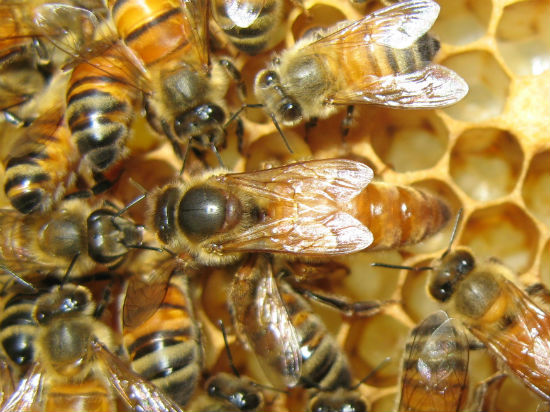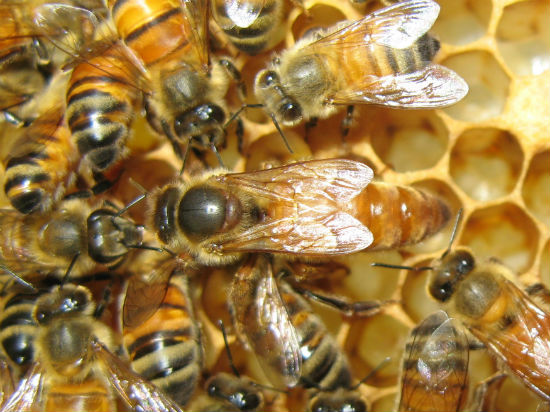
Royal Jelly is a unique substance. It’s a secretion made by honeybees that’s fed to the Queen Bee that allows it to grow big and strong. Bees have a very lopsided caste system, and it’s all due to this mysterious compound which is one of nature’s most biologically active tonics.
It also exerts a variety effects in humans too. Various clinical trials have shown that it helps control blood sugar, suppress tumors, and improve circulation, among other things.
But despite its powerful effects, the details about its mechanism are mostly unknown, especially in humans.
And more importantly, how it ought to be used is still an issue that isn’t settled.
This piece is the first of three that’s aiming to clarify the fog around what royal jelly can do for you, how to use it, which products to buy, and how the quality of royal jelly is maintained.
What Royal Jelly Can Do
In bee hives the differences between the Queen Bee and worker bee is staggering. She develops more quickly, has more fertility, is bigger, stronger, and lives one to four years. Worker bees live three to six weeks. The only difference between the two is their food source. Queen bees feed on royal jelly and worker bees don’t.
In the human body royal jelly to some degree has been shown to have the following effects:
- Improve fat metabolism (ie, inhibit lipid peroxidation)
- Improve cholesterol levels
- Control blood sugar and limit the secretion of insulin and insulin growth factor
- Mediate wound healing on the skin
- Improve vasodilation and circulation
- Inhibit cell and tumor growth
That’s an impressive list. (Important: I’m not saying royal jelly unequivocally does those things for all people at all doses, just stating that there are examples of such affects under certain circumstances. I’m not a medicine man).
For me the most unique effect of royal jelly is its ability to extend lifespans. Queen bees live much longer than worker bees, but what’s interesting is the life extending effects of royal jelly are found when you feed it to other organisms as well.
Consistent treatment of royal jelly has been shown to extend lifespan in C. Elegans, fruit flies and mice by as much as 18%. The mechanisms of longevity are very well conserved in nature and it’s plausible royal jelly could have similar effects on humans…..to some degree.
The reason for this effect is probably due to its ability to inhibit insulin production. I’ve written before that low insulin levels are the common denominator in people that live a long time, and royal jelly improves insulin resistance and down regulates genes that code for insulin like peptides.
Improved insulin balance = longer life.
What Makes Royal Jelly Tick?
So royal jelly does a lot of unique things in the body……but what gives it these seemingly magical powers?
To answer that question it’s a good idea to begin with what doesn’t do it. It’s 67% water, and 10% sugar. Nothing remarkable about that.
Instead it looks like the family jewels come from a grab bag of pharmacologically active proteins and a unique fatty acid. The two most prominent are a protein called royalisin, and a fatty acid called 10-hydroxy-2-decenoic acid (10-hda). Together they give royal jelly the juice it needs to exert its healing effects.
The challenge for the citizenry is that the most important nutrients in royal jelly are remarkably fragile.
Using Royal Jelly Supplements
Most studies done on the composition of royal jelly find that it degrades very easily, particularly when exposed to heat. In worst case scenarios a supplement won’t have a lick of its biologically active ingredients. You’re essentially paying an arm and a leg for watered down honey. Not cool.
When it comes to using royal jelly here are the important details:
- Store it cold! Heat is absolutely killer to royal jelly, but if you keep it frozen most of its nutrients preserve themselves remarkably well
- Use it over longer periods of time. In short time frames royal jelly doesn’t do anything. For whatever reason, it takes royal jelly weeks if not months to exert its effects. It’s best to use it consistently for months at a time.
- When it comes to dosage, quality is more important than quantity. Because the nutrient density of different supplements is all over the map, it’s hard to say the exact amount you ought to take. In studies the dosage used is all over the map too. Amounts ingested range from 50mg to 3000mg. The latter is probably out of the question for most people. Unless you want to spend $250 a month eating royal jelly. As a rule of thumb I think it’s good to shoot for at least 150 mg if you’re taking a high end supplement and somewhere between 500-1000mg if you’re taking a cheaper one.
Because the activity of royal jelly is so concentrated in a handful of compounds it’s not a bad idea to take a royal jelly concentrate. This might save you some bucks and possibly improve your results….but this is heresay on my part, so don’t take that advice as gospel.
And of course, it’s ultimately something you just need to try out for yourself.
Going Forward: The Best Products and Why
At this point there are a lot of natural questions you might be thinking.
How can I tell if a royal jelly supplement is any good or not? That it was handled carefully? ? Will it help with “X” condition?
Luckily these issues will be covered in parts 1 and 2 of our treatment on royal jelly. My favorite company for bee products is BeeAlive, and I’ll be taking a very close look at their line of royal jelly supplements.
That’ll be followed with an interview with its founders about how the company actually makes its product and how it got started. (And no, they don’t pay me anything).
For someone who’s concerned about the quality control process used in making health supplements, it’ll be supplement porn. It’ll also provide unique insights into how a high quality supplement company actually operates for all you aspiring healthpreneurs out there.
References
Howe, S.R., et. al “Composition of freshly harvested and commercial royal jelly”
URL: http://www.ibra.org.uk/articles/Composition-of-freshly-harvested-and-commercial-royal-jelly
Genc, et. al. “Determination of trans-10-hydroxy-2-decenoic acid content in pure royal jelly and royal jellyproducts by column liquid chromatography.”
URL: http://www.ncbi.nlm.nih.gov/pubmed/10327631
Yoka, Hondo, et. al. “Lifespan-Extending Effects of Royal Jelly and Its Related Substances on the Nematode Caenorhabditis elegans”
URL: http://www.ncbi.nlm.nih.gov/pmc/articles/PMC3153499/
Yasunari, Kayashima, et. al. “Freeze-Dried Royal Jelly Maintains Its Developmental and Physiological Bioactivity in Drosophila melanogaster”
URL: https://www.jstage.jst.go.jp/article/bbb/76/11/76_120496/_article
Kamakuri, Masaki, et. al. “Royalactin induces queen differentiation in honeybees”
URL: http://www.nature.com/nature/journal/v473/n7348/full/nature10093.html
Fujiwara, Suguru, et. al. “A Potent Antibacterial Protein in Royal Jelly”

[…] I’ve written about its health benefits in the past, and recently covered the challenges of using royal jelly in supplement form. […]
LikeLike
I’ll something about Royal Jelly to my website sometime. Please feel free to use other resources on my blog and thanks for the reference.
LikeLike
No problem at all man!
LikeLike